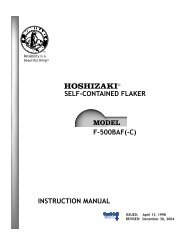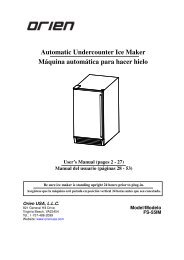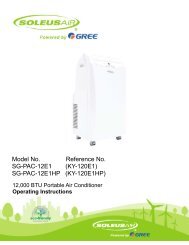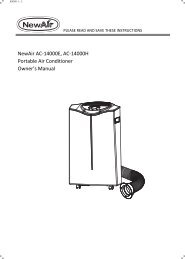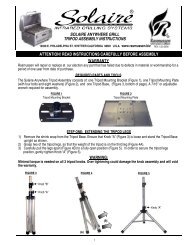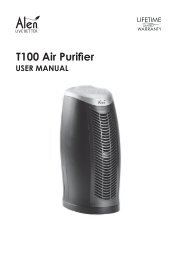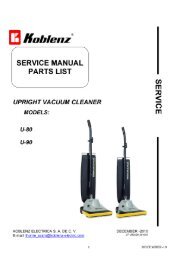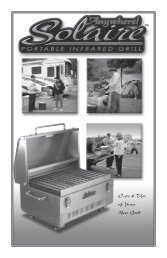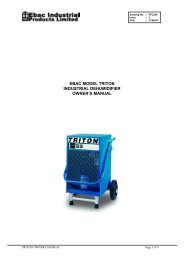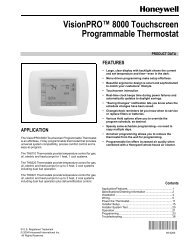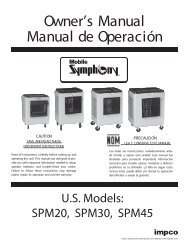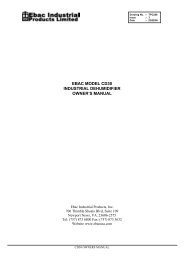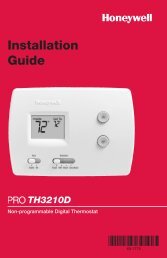68-0133 - Y8610U Intermittent Pilot Retrofit Kit - Air & Water
68-0133 - Y8610U Intermittent Pilot Retrofit Kit - Air & Water
68-0133 - Y8610U Intermittent Pilot Retrofit Kit - Air & Water
Create successful ePaper yourself
Turn your PDF publications into a flip-book with our unique Google optimized e-Paper software.
If the desired outlet gas pressure or gas flow rate<br />
cannot be achieved by adjusting the gas control, check<br />
the gas control inlet pressure using a manometer at the<br />
inlet pressure tap. If the inlet pressure is in the normal<br />
range, replace the gas control; otherwise, take the<br />
necessary steps to provide proper gas pressure to the<br />
gas control.<br />
STEP 6: Adjust <strong>Pilot</strong> Flame.<br />
The pilot flame should envelop 3/8 to 1/2 in. (10 to 13 mm) of<br />
the ground rod and tip of the igniter-sensor. See Fig. 17 to<br />
adjust the pilot flame.<br />
PROPER FLAME<br />
ADJUSTMENT<br />
IGNITER-SENOR TIP IN PILOT FLAME<br />
PILOT GAS<br />
TUBING<br />
GROUND ROD<br />
ELECTRODE SCREW<br />
IGNITER-SENSOR<br />
ASSEMBLY<br />
IGNITION<br />
CABLE<br />
STUD<br />
TERMINAL<br />
Fig. 17. Proper flame adjustment.<br />
M4677<br />
Remove the pilot adjustment cover screw. See Fig. 3.<br />
Turn the inner adjustment screw clockwise to decrease<br />
or counterclockwise to increase the pilot flame.<br />
Always replace the cover screw after adjustment and<br />
tighten firmly.<br />
STEP 7: Check Other System Components<br />
• On Furnaces: Make sure the limit controller and fan<br />
controller are operating in accordance with the appliance<br />
manufacturer instructions.<br />
• On Boilers: Make sure the circulating water pumps, low<br />
water cutoffs, automatic feed controllers, pressure and<br />
temperature limit controllers, and relief valves are<br />
operating in accordance with the appliance manufacturer<br />
recommendations.<br />
STEP 8: Check Normal Operation<br />
• Set the thermostat or controller above the room<br />
temperature to call for heat.<br />
• Make sure the pilot lights smoothly when the gas reaches<br />
the pilot burner.<br />
13<br />
<strong>Y8610U</strong> INTERMITTENT PILOT RETROFIT KIT<br />
• Make sure the main burner lights smoothly without<br />
flashback.<br />
• Make sure the main burner operates smoothly without<br />
floating, lifting, or flame rollout to the furnace vestibule or<br />
heat buildup in the vestibule.<br />
• If the gas line has been disturbed, complete the Gas Leak<br />
Test following Step 1.<br />
• Turn the thermostat or controller below the room<br />
temperature. Make sure the main burner and pilot flames<br />
go out.<br />
OPERATION<br />
System operation is divided into two stages:<br />
1. Trial for ignition.<br />
2. Main burner operation.<br />
See Fig. 18 for the normal operating sequence.<br />
Trial for Ignition<br />
<strong>Pilot</strong> Ignition<br />
Following the call for heat, the module energizes the first<br />
main valve operator. The first main valve opens, which allows<br />
gas to flow to the pilot burner. At the same time, the electronic<br />
spark generator in the module produces a high voltage spark<br />
pulse output. The voltage generates a spark at the ignitersensor<br />
that lights the pilot.<br />
If the pilot does not light, or the pilot flame current is not at<br />
least 1.0 uA and steady, the module can not energize the<br />
second (main) valve and the main burner can not light. After<br />
90 seconds maximum, the system shuts off and the pilot<br />
valve closes; trial for ignition restarts after a minimum of five<br />
minutes (six minutes nominal). Ignition, shutoff, and wait<br />
sequence repeats until pilot lights or call for heat ends.<br />
Main Burner Operation<br />
When the pilot flame is established, a flame rectification<br />
circuit is completed between the sensor and burner ground.<br />
The flame sensing circuit in the module detects the flame<br />
current, shuts off the spark generator and energizes the<br />
second main valve operator. The second main valve opens<br />
and gas flows to the main burner, where it is ignited by the<br />
pilot burner.<br />
When the call for heat ends, both valve operators are deenergized,<br />
and both valves in the gas control close.<br />
<strong>68</strong>-<strong>0133</strong>—2



